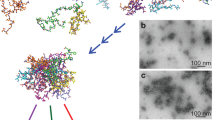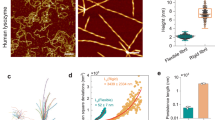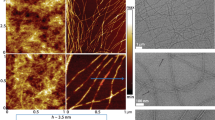Abstract
Synchrotron X-ray scattering was performed on an aqueous solution containing self-assembled aggregates of a β-sheet-forming peptide conjugated with a water-soluble moiety (polyethylene glycol, PEG or an oligo-peptide comprising a transactivator of transcription, TAT, sequence). The angular dependence of the scattering intensity in the low-q region (that is, q<2.0 nm−1, where q is the magnitude of the scattering vector) indicated that the scattering objects were rod-like and completely dispersed in water without undergoing secondary aggregation. From the scattering intensity in the range of 0.5 nm−1<q<5.0 nm−1, it was deduced that the cross-section of the scattering objects was rectangular and not circular, presumably because of the laminated structure of the β-sheets. In the wide-angle region (that is, q<5.0 nm−1), a diffraction peak was observed at q=13.4 nm−1, which could be assigned to the two neighboring α-carbons of the peptide chains of the cross-section of the β-sheet. The scattering data indicated that the β-sheet-forming peptide indeed formed stacked β-sheets in a manner similar to that observed in the case of amyloid protofilaments, and that the resultant rod-like objects could be completely dispersed in water as a result of the hydrophilic PEG or TAT moiety.
Similar content being viewed by others


Log in or create a free account to read this content
Gain free access to this article, as well as selected content from this journal and more on nature.com
or
References
Jiménez, J. L., Nettleton, E. J., Bouchard, M., Robinson, C. V., Dobson, C. M. & Saibil, H. R. The protofilament structure of insulin amyloid fibrils. Proc. Natl Acad. Sci. USA 99, 9196–9201 (2002).
Knowles, T. P. & Buehler, M. J. Nanomechanics of functional and pathological amyloid materials. Nat. Nanotechnol. 6, 469–479 (2011).
Maji, S. K., Perrin, M. H., Sawaya, M. R., Jessberger, S., Vadodaria, K., Rissman, R. A., Singru, P. S., Nilsson, K. P. R., Simon, R. & Schubert, D. Functional amyloids as natural storage of peptide hormones in pituitary secretory granules. Science 325, 328–332 (2009).
Mostaert, A. S., Higgins, M. J., Fukuma, T., Rindi, F. & Jarvis, S. P. Nanoscale mechanical characterisation of amyloid fibrils discovered in a natural adhesive. J. Biol. Phys. 32, 393–401 (2006).
Nelson, R., Sawaya, M. R., Balbirnie, M., Madsen, A. O., Riekel, C., Grothe, R. & Eisenberg, D. Structure of the cross-[beta] spine of amyloid-like fibrils. Nature 435, 773–778 (2005).
Chiti, F., Bucciantini, M., Capanni, C., Taddei, N., Dobson, C. M. & Stefani, M. Solution conditions can promote formation of either amyloid protofilaments or mature fibrils from the HypF N-terminal domain. Protein Sci. 10, 2541–2547 (2001).
Colombo, G., Soto, P. & Gazit, E. Peptide self-assembly at the nanoscale: a challenging target for computational and experimental biotechnology. Trends Biotechnol. 25, 211–218 (2007).
Cui, H., Cheetham, A. G., Pashuck, E. T. & Stupp, S. I. Amino acid sequence in constitutionally isomeric tetrapeptide amphiphiles dictates architecture of one-dimensional nanostructures. J. Am. Chem. Soc. 136, 12461–12468 (2014).
Pashuck, E. T., Cui, H. & Stupp, S. I. Tuning supramolecular rigidity of peptide fibers through molecular structure. J. Am. Chem. Soc. 132, 6041–6046 (2010).
Deechongkit, S., Powers, E. T., You, S.-L. & Kelly, J. W. Controlling the morphology of cross β-sheet assemblies by rational design. J. Am. Chem. Soc. 127, 8562–8570 (2005).
Waku, T., Kitagawa, Y., Kawabata, K., Nishigaki, S., Kunugi, S. & Tanaka, N. Self-assembled β-sheet peptide nanofibers for efficient antigen delivery. Chem. Lett. 42, 1441–1443 (2013).
Fukuhara, S., Nishigaki, T., Miyata, K., Tsuchiya, N., Waku, T. & Tanaka, N. Mechanism of the chaperone-like and antichaperone activities of amyloid fibrils of peptides from αA-crystallin. Biochemistry 51, 5394–5401 (2012).
Tanaka, N., Tanaka, R., Tokuhara, M., Kunugi, S., Lee, Y.-F. & Hamada, D. Amyloid fibril formation and chaperone-like activity of peptides from αA-crystallin. Biochemistry 47, 2961–2967 (2008).
Sunde, M., Serpell, L. C., Bartlam, M., Fraser, P. E., Pepys, M. B. & Blake, C. C. Common core structure of amyloid fibrils by synchrotron X-ray diffraction. J. Mol. Biol. 273, 729–739 (1997).
Hamley, I. W. & Krysmann, M. J. Effect of PEG crystallization on the self-assembly of PEG/peptide copolymers containing amyloid peptide fragments. Langmuir 24, 8210–8214 (2008).
Avdeev, M. V., Aksenov, V. L., Gazová, Z., Almásy, L., Petrenko, V. I., Gojzewski, H., Feoktystov, A. V., Siposova, K., Antosova, A., Timko, M. & Kopcansky, P. On the determination of the helical structure parameters of amyloid protofilaments by small-angle neutron scattering and atomic force microscopy. J. Appl. Crystallogr. 46, 224–233 (2013).
Akiba, I., Terada, N., Hashida, S., Sakurai, K., Sato, T., Shiraishi, K., Yokoyama, M., Masunaga, H., Ogawa, H., Ito, K. & Yagi, N. Encapsulation of a hydrophobic drug into a polymer-micelle core explored with synchrotron SAXS. Langmuir 26, 7544–7551 (2010).
Roe, R.-J. Methods of X-ray and Neutron Scattering in Polymer Science, (Oxford Univ. Press on Demand, 2000).
Glatter, O. & Kratky, O. Small Angle X-ray Scattering, (Academic, 1982).
Smith, K. F., Harrison, R. A. & Perkins, S. J. Molecular modeling of the domain structure of C9 of human complement by neutron and x-ray solution scattering. Biochemistry 31, 754–764 (1992).
Lashuel, H. A., LaBrenz, S. R., Woo, L., Serpell, L. C. & Kelly, J. W. Protofilaments, filaments, ribbons, and fibrils from peptidomimetic self-assembly: implications for amyloid fibril formation and materials science. J. Am. Chem. Soc. 122, 5262–5277 (2000).
Circular Dichroism: Principles and Applications, 2nd edn (John Wiley & Sons Inc, 2000).
Dukor, R. K. & Keiderling, T. A. Reassessment of the random coil conformation: vibrational CD study of proline oligopeptides and related polypeptides. Biopolymers 31, 1747–1761 (1991).
Hilderson, J. H. & Ralston, G. B. in Subcellular Biochemistry, Vol. 23 (eds Hilderson, J. H & Ralston, G. B.) (Plenum Press, New York, NY, USA, 1994).
Acknowledgements
All the SAXS and WAXS measurements were performed at the SPring-8 facility, Japan (2013A1207, 2013B1203). This work was supported by the Photon and Quantum Basic Research Coordinated Development Program of the Ministry of Education, Culture, Sports, Science and Technology (MEXT), Japan and by the Photon and Quantum Basic Research Coordinated Development Program of MEXT, Japan.
Author information
Authors and Affiliations
Corresponding author
Ethics declarations
Competing interests
The authors declare no conflict of interest.
Additional information
Supplementary Information accompanies the paper on Polymer Journal website
Supplementary information
Rights and permissions
About this article
Cite this article
Minami, T., Matsumoto, S., Sanada, Y. et al. Rod-like architecture and cross-sectional structure of an amyloid protofilament-like peptide supermolecule in aqueous solution. Polym J 48, 197–202 (2016). https://doi.org/10.1038/pj.2015.97
Received:
Revised:
Accepted:
Published:
Issue date:
DOI: https://doi.org/10.1038/pj.2015.97

